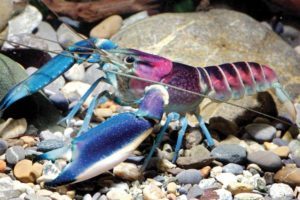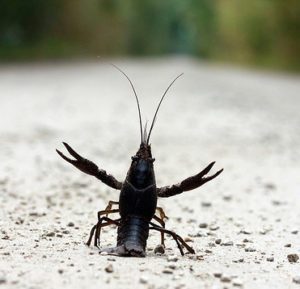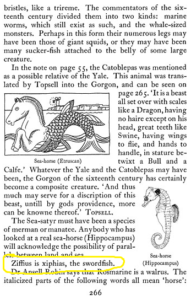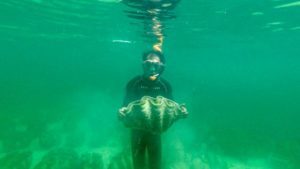Podcast: Play in new window | Download (Duration: 15:18 — 16.4MB)
Hello from Finland! While I’m far from home, I’m thinking of animals of my native land. So join me to learn about crawdads (aka crayfish aka crawfish aka freshwater lobsters aka everything) and cicadas!
A lovely blue crayfish from Indonesia:

Fite me

The giant Tasmanian crayfish:

A periodical cicada:

A cicada killer about to do horrible things to a cicada. Nature is disgusting.

Show transcript:
Welcome to Strange Animals Podcast. I’m your host, Kate Shaw.
For this week’s episode, which I’m putting together right before I leave for Finland on a madcap two-week adventure—okay, two weeks staying in the city of Helsinki while attending a conference and eating a lot of pastries—I’m going to look at two invertebrates that live close to home. The first is the crawdad. I’ve always wondered if those muddy holes near creeks and streams that we call crawdad holes around here are actually crawdad holes. Sometimes they’re nowhere near water. So I looked it up.
Yes, they are actually holes dug by crawdads. So that’s one mystery solved. The crawdad has a lot of different names depending on where you live: crayfish, crawfish, mountain lobsters, freshwater lobsters, mudbugs, and many other names. In Australia they may be called yabbies. There are a lot of species throughout the world, most of them in North America. Some also live in South America, Australia, New Zealand, Madagascar, Japan, and Europe. In fact, they live everywhere except Africa and Antarctica.
Crawdads are freshwater crustaceans and eat just about anything. Some species prefer running water, others like still water, but they all need clean water. If you find crawdads in the creek behind your house, you can be happy to know the creek has clean water—but don’t drink it, seriously. That’s a gross story for another time, but trust me, don’t drink untreated water.
Crawdads look like little lobsters and are closely related to them, and people do eat them. Some species are kept as pets in freshwater aquariums, although if you add them to your aquarium definitely make sure you’re not just providing your fish with a crunchy new snack, since a lot of fish eat crustaceans. Also keep in mind that many species of crawdad like to climb and dig so can make a mess of your nicely arranged tank.
One especially sought-after aquarium crawdad is a blue crayfish. Like blue lobsters, crawdads of normally drab colored species are occasionally found that are bright blue. It’s rare but not ridiculously rare. But there aren’t very many species that are always blue. This particular crawdad is beautiful, purplish pink on its body with blue and white claws and legs. But when they started showing up in the pet trade in the early 2000s, scientists didn’t have any idea what species they were. And the pet sellers weren’t telling where they were found.
After some digging, German researcher Christian Lukhaup traced the crawdads to a creek in Indonesia. It’s a new species, announced in 2015. We don’t know how widespread it is. Researchers worry it may be rare and threatened, and unfortunately most of the ones sold as pets have been gathered from the wild.
Many species of crawdads dig burrows. The bottom of the burrow ends in water, whether it’s a creek or the water table or just wet mud. Crawdads breathe through gills, but their gills are in their abdomen under their shell. As long as the gills are wet, the crawdad doesn’t have to actually be in the water to breathe. Crawdads are nocturnal animals and stay in their burrows during the day, then come out at night. The top of the burrow is usually surrounded by mud that the crawdad has pushed out of its hole. Other crawdad species live under rocks.
One of the smallest crawdad species is found in eastern Australia. It’s less than an inch long—usually only 12 to 18 millimeters in length, not counting its antennae—and is called a lake yabby or eastern swamp crayfish. It was only discovered a few years ago. It’s bluish-black and spends a lot of its time in its burrow, which usually reaches down to the water table so the yabby can survive during the dry season, when the shallow lakes and swamps where it lives may dry up completely.
New species of crawdad are found all the time. In 2009 a possible new species was reported in Tennessee. Two biologists, one from the University of Illinois and the other from Eastern Kentucky University, took a research trip to Shoal Creek, near the Tennessee-Alabama border. The very first crawdad they found, after only two hours of searching, turned out to be a new species—and it’s not exactly small. It’s some five inches long, which is roughly the length between the tip of my pinky finger and the base of my palm. I just measured out of curiosity. Most crawdads in the area are about half that length. DNA testing confirmed that it’s a new species and it was formally described in 2010. It’s related to another big crawdad found in Kentucky and Tennessee, which can grow up to 9 inches long. Both species appear to be rare and live under rocks in the deepest parts of a few streams and small rivers.
The biggest species of crawdad living is the Tasmanian giant freshwater lobster. It lives a long time, up to 60 years, if nothing eats it, and can weigh as much as 13 pounds and grow over two and a half feet long.
There are mysteries associated with the crawdad. For instance, most of Asia doesn’t have crawdads at all, but the ones that are found in Asia are more closely related to the crawdads of the southeastern United States than the crawdads of the southeastern United States are related to the crawdads of the northwestern United States. The northwestern U.S. crawdads appear more closely related to those found in Europe. But the big mystery is why there aren’t any crawdads in Africa.
Crawdads evolved from their marine ancestors around 200 million years ago. Around the same time, a big chunk of the earth’s land was smushed together in a big continent called Gondwana. The continents move around all the time—very, very slowly from a human perspective—due to plate tectonics. That’s why some of the animals found in, for instance, South America are closely related to animals found in Africa, because those two continents were once joined together. If you look on a map or globe you can even see that they fit together like puzzle pieces.
So crawdads evolved when Gondwana was just starting to break up into smaller continents. That explains why there are so many crawdads in different parts of the world—crawdads had time to spread out across much of Gondwana before it broke apart. But what would later be called Africa was right in the middle of Gondwana, and we know it had plenty of freshwater that crawdads could have lived in. Why didn’t crawdads populate that area?
It’s possible they did, but that as Africa moved farther toward the equator over millions of years, the crawdads died out. Crawdads prefer temperate climates—not too hot and not too cold. But there are two problems with that hypothesis. First, we haven’t found any crawdad fossils anywhere in Africa. By itself that’s not too unusual, since arthropods don’t fossilize well. They don’t have bones and their shells decompose relatively quickly. Plus, everything eats them so they don’t typically lie around undisturbed in the mud. But the other problem is more, well, problematic. Africa is a huge continent and most of it has never been that close to the equator. Parts of it have always been rainy and temperate, the perfect crawdad environment. And the island of Madagascar, which separated from Africa some 135 million years ago, does have crawdads. Plus, there are crawdads in parts of Australia that are much warmer than most of Africa. Plus, crawdads from the United States have been introduced into parts of Africa and have done so well they’re now an invasive species. What gives?
Africa does have a lot of freshwater crabs, which occupy the same ecological niche that crawdads do. It’s possible crawdads might have been outcompeted by the crabs. But freshwater crabs prefer tropical climates, not temperate. And in the parts of Africa where crawdads have been introduced, they’re actually thriving so well they’re endangering the native freshwater crabs.
So at the moment, we don’t know why Africa doesn’t have any native crawdads. The reason is probably more complicated than any one thing. For instance, if crawdads in one area were already dealing with freshwater crabs horning in on their food sources and territories, and the temperature was steadily increasing over the centuries, any little setback might have caused the crawdads to go extinct.
There are rumors of gigantic crawdads yet to be discovered. The remote Japanese Lake Mashu, formed some 11,000 years ago in the crater of a dormant volcano, is supposedly home to giant crayfish. There are rumors that trout poachers in 1978 and 1985 captured huge crawdads in the lake, although no pictures exist and no one is sure how big huge is supposed to be in this case. There is one report of a crawdad some two feet long found in the lake. A fisherman also reported seeing one that was three feet long, although he didn’t capture or measure it. As far as we know, the only crawdad living in the lake is a North America species introduced into the lake in the 1930s. It typically grows around 6 inches long, but a 1992 study of the lake’s crawdads didn’t find any larger than two and a half inches long.
During World War II, Australian marines patrolling swampland in Borneo found a crawdad that measured more than four feet long and weighed 49 pounds. It was caught in fresh water although it resembled a marine lobster. The marines nicknamed it Bagaton. The corpse was kept but so far it hasn’t been studied, but take this whole story with a grain of salt because I can only find two sources online that mention it at all.
While I was finishing up my crawdad research, I was on Twitter complaining that I didn’t quite have enough information for a full episode and I wasn’t sure what animal to pair it with. One of the hosts of Rumor Flies, an awesome podcast about rumors and myths, suggested cicadas. That made perfect sense to me, since cicadas are THE sound of summer in the southeastern United States.
I happen to love the sound of cicadas. Yes, they’re loud, but I find their chiming restful. Cicadas call during the day when it’s hottest, not at night—the insects you hear at night are usually katydids and tree crickets. This is what cicadas sound like.
[cicada sound—really you are not missing much, it’s just a rhythmic drone that I find soothing]
On the other hand, cicadas are creepy-looking although they’re harmless. When I was very small I was afraid of cicada shells, which are what’s left behind when a cicada hatches from its nymph form into its adult form. The adult cicada has wings and the male has a really, really loud song—so loud that he disengages his own hearing while he sings so he won’t deafen himself. Cicadas don’t have ears like mammals, they have a membraneous structure called tympana that detects sound. Males produce their loud songs with a structure called a tymbal in their abdomen. The abdomen is mostly hollow, which helps amplify the rapid clicking of the tembals. Some cicada songs are louder than 120 decibels, which is the same decibel level as a chainsaw.
There are a lot of cicada species around the world, but most live in the tropics. Seven species are known as periodical cicadas, which live most of their lives underground as nymphs, eating sap from the roots of certain trees, but emerge from underground as adults all at once. They sing, mate, lay eggs, and die in a matter of weeks, and the babies that hatch from their eggs don’t emerge from underground for another 13 or 17 years, depending on the species. Other cicada species have similar life cycles, but they don’t all emerge from underground at the same time—some emerge every summer while others remains as nymphs.
Cicadas are eaten by birds, bats, spiders, and even squirrels. There’s even a wasp called a cicada killer that preys specifically on cicadas—it captures a cicada, takes it back to its underground nest, and lays eggs in it. The eggs hatch and eat the cicada’s insides. BUT THE CICADA IS STILL ALIVE. I try not to think about insects too often. Cicada killers have black and yellow stripes like yellow jackets, but are much larger, up to two inches long. They will sting but only if provoked. They have to be big because cicadas are big insects, also about two inches long in most species.
Cicadas are edible, and are considered delicacies in many cultures. The females are meatier since the males have that hollow abdomen. In case you were wondering what to look for when you go shopping.
You can find Strange Animals Podcast online at strangeanimalspodcast.com. We’re on Twitter at strangebeasties and have a facebook page at facebook.com/strangeanimalspodcast. If you have questions, comments, or suggestions for future episodes, email us at strangeanimalspodcast@gmail.com. If you like the podcast and want to help us out, leave us a rating and review on iTunes or whatever platform you listen on. We also have a Patreon if you’d like to support us that way. For only a dollar pledge a month on Patreon you’ll have access to all the patron-only episodes, which I release twice a month. Some recent episodes have covered scientists eating mammoth meat, animals with weird teeth, and the Beast of Busco. Also you get stickers.
Thanks for listening!







































